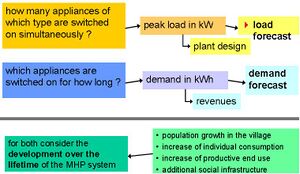Click here to register!
Social Implications of Load Management
Load management is the process of balancing the supply of electricity on the network with the electrical load by adjusting or controlling the load rather than the power station output. This can be achieved by direct intervention of the utility in real time or by time clocks, or by using special tariffs to influence consumer behavior.
Definition by Wikipedia
Definition of the problem
Stand-alone hydropower schemes are often characterised by high load peaks but low average energy demand. This is particularly the case with community
electrification schemes in developing countries where average demand can be as low as 15 to 20% of the peak demand. This has two main disadvantages:
- Generators are invariably overloaded at peak times. This results in under voltage operation for small overloads and repeated tripping for large overloads. The result is customer dissatisfaction and productivity losses where there are income-generating activities.
- During times of low demand, the power from the hydro is only partially utilised and, since most stand-alone schemes are run-of-river, available energy is wasted. This reduces the benefits to the recipients and the overall cost-effectiveness of the scheme.
Power demand and end use possibilities
The demand for power and end use possibilities should be accessed during the phase of feasibility studies. The primary use of micro-hydropower in the rural context of the country is usually for household lighting. Thus, in order to optimise the use of the micro-hydropower plant (and thus increase its financial viability), the installed capacity should be governed by household demand. The end uses (non -lighting uses) should ideally complement the lighting use. If the end uses are such that they can be operated during the non -lighting hours, the size of the scheme need not be unnecessarily increased. Thus, at any time, the total capacity of end uses under operation should be limited to the installed capacity, which is governed by the lighting demand. However, other approaches to sizing the plant capacity may also be proposed, provided that the financial viability can be demonstrated.
In order to access the power requirements, the number of beneficiary households and the average power demand per household should be determined based on discussions with the community. As mentioned earlier attempts should be made to strike a balance between the technical aspects of the scheme and the demand of the community for electricity. Similarly, the type of end uses, their capacities and exp ected annual operating time based on local resources available and market opportunity should de determined. The prospective entrepreneurs willing to install the various end uses should be identified at the detailed feasibility stage.
Forecast and management of load and demand
Why demand forecast?
- electricity production should cover the demand at any time,
- in case of insufficient hydropower potential (load management, demand side management, back-up solutions)
- mostly revenues (and thus also the cash flow) depend on electricity consumption
Forecast should be made for the different users / user groups:
- domestic consumption
- consumption of social infrastructure (public and service consumption): schools, health centers, mosques, churches, street lighting, administration etc.
- productive use (milling and other agricultural processing, kiosks, welding and carpentry workshops, etc.)
How to make a forecast:
Load and demand side management by reducing peaks and/or demand:
- sensitising consumers/ awareness raising (e.g. by energy-savign bulbs, promotion of productive end use, etc.)
- creating special tariff system, e.g. combined with installation of current limiters
Load forecast modell
The Modell was developed in Ethiopia, please check with EnDev Ethioipa (Bart-Jan) if it can be distributed.
Further reading: Improving Efficiency and Accessibility of Micro-Hydro Power Through Intelligent Load Management (case study from Uganda)




















